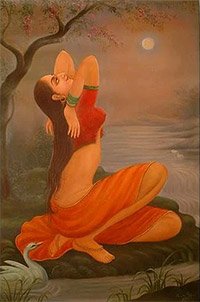Udakavadya, Udaka-vadya, Udakavādya: 6 definitions
Introduction:
Udakavadya means something in Hinduism, Sanskrit, Marathi. If you want to know the exact meaning, history, etymology or English translation of this term then check out the descriptions on this page. Add your comment or reference to a book if you want to contribute to this summary article.
In Hinduism
Kama-shastra (the science of Love-making)
Source: Shodhganga: Elements of Art and Architecture in the Trtiyakhanda of the Visnudharmottarapurana (kama)Udakavādya (उदकवाद्य) refers to “playing of musical instrument like muraja” and represents one of the “sixty four kinds of Art”, according to the Kāmasūtra of Vātsyāyaṇa.—Indian tradition, basically includes sixty four Art forms are acknowledged. The references of sixty four kinds of kalā are found in the Bhāgavatapurāṇa, Śaiva-Tantras, Kāmasūtra of Vātsyāyaṇa etc.

Kamashastra (कामशास्त्र, kāmaśāstra) deals with ancient Indian science of love-making, passion, emotions and other related topics dealing with the pleasures of the senses.
Languages of India and abroad
Marathi-English dictionary
Source: DDSA: The Molesworth Marathi and English Dictionaryudakavādya (उदकवाद्य).—n S A musical instrument composed of glasses having different depths of water; musical glasses with water.
Marathi is an Indo-European language having over 70 million native speakers people in (predominantly) Maharashtra India. Marathi, like many other Indo-Aryan languages, evolved from early forms of Prakrit, which itself is a subset of Sanskrit, one of the most ancient languages of the world.
Sanskrit dictionary
Source: DDSA: The practical Sanskrit-English dictionaryUdakavādya (उदकवाद्य).—'water music' (performed by striking cups filled with water; cf. jalataraṅga), one of the 64 Kalās; Vātsyāyana.
Derivable forms: udakavādyam (उदकवाद्यम्).
Udakavādya is a Sanskrit compound consisting of the terms udaka and vādya (वाद्य).
Source: Cologne Digital Sanskrit Dictionaries: Monier-Williams Sanskrit-English DictionaryUdakavādya (उदकवाद्य):—[=udaka-vādya] [from udaka > und] n. ‘water-music’ (performed by striking cups filled with water), one of the 64 Kalās or fine arts, [Vātsyāyana] (cf. jala-taraṅgiṇī.)
[Sanskrit to German]
Sanskrit, also spelled संस्कृतम् (saṃskṛtam), is an ancient language of India commonly seen as the grandmother of the Indo-European language family (even English!). Closely allied with Prakrit and Pali, Sanskrit is more exhaustive in both grammar and terms and has the most extensive collection of literature in the world, greatly surpassing its sister-languages Greek and Latin.
See also (Relevant definitions)
Partial matches: Vadya, Udaka.
Full-text: Musical instrument, Playing, Vadya, Causashtakala.
Relevant text
Search found 4 books and stories containing Udakavadya, Udaka-vadya, Udaka-vādya, Udakavādya; (plurals include: Udakavadyas, vadyas, vādyas, Udakavādyas). You can also click to the full overview containing English textual excerpts. Below are direct links for the most relevant articles:
The Bhagavata Purana (by G. V. Tagare)
The Sixty-four arts and crafts (Kalā) < [Appendices]
Vishnudharmottara Purana (Art and Architecture) (by Bhagyashree Sarma)
3. A General Note on Art < [Chapter 1 - Introduction]
Kamashastra Discourse (Life in Ancient India) (by Nidheesh Kannan B.)
7.1. The Sixty-four Fine Arts < [Chapter 5 - Looking for Alternatives: Possibilities in Kāmaśāstra]
Malatimadhava (study) (by Jintu Moni Dutta)
Part 3 - Art and Architecture in the Mālatīmādhava and 8th-century India < [Chapter 4 - Cultural Aspects of the Mālatīmādhava]